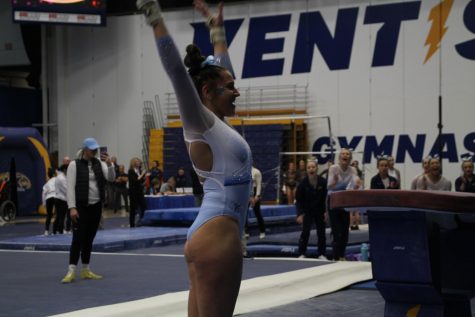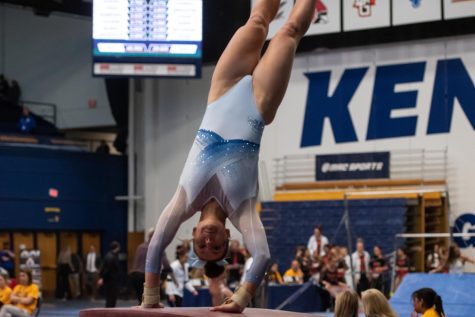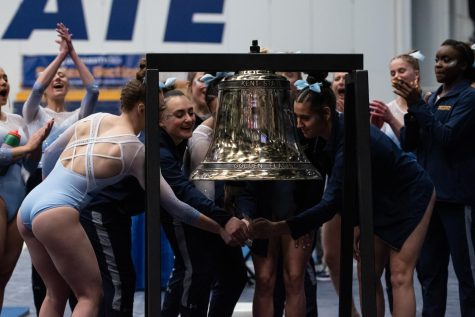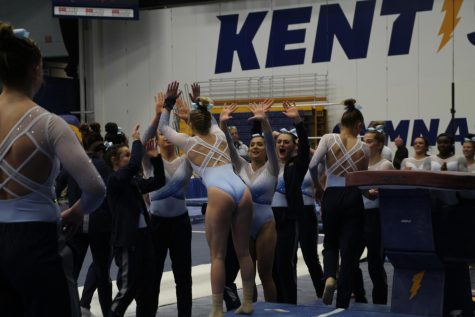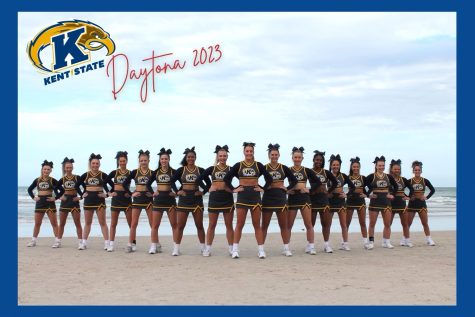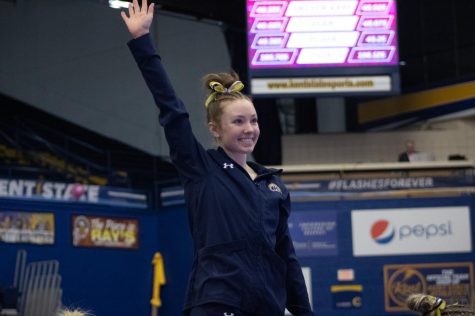Kent State one of few major “innocent” schools
July 12, 2011
Kent State is one of only 17 “innocent” Football Bowl Subdivision schools that have never been found guilty of major violations since the NCAA began tracking them 58 years ago.
Since the Flashes don’t have the same win-at-all-cost and profitability pressures as major programs like Ohio State or Alabama, they are less likely to have the violations that go along with those stressors, former Kent State athletic director Laing Kennedy said.
Kennedy highlighted the differences between a major-conference program like Ohio State, where football coach Jim Tressel resigned amid allegations of major rule violations, and a “mid-major” program like Kent State that has never been found guilty of major violations, but also has never turned a profit from sports.
High-profile cases
Heisman winner and Auburn quarterback Cam Newton was reportedly “shopped” around to schools before he joined the Tigers; his father supposedly sought more than $100,000 from Mississippi State. Former Southern California running back Reggie Bush lost his Heisman trophy after the NCAA learned he and his family were receiving benefits from a sports agent. The list goes on. Here are several high-profile cases that broke, and that the NCAA is still investigating, since the college football season ended in January:
OHIO STATE – Jim Tressel resigned as football coach after nine seasons in Columbus. Earlier in the year, reports revealed Tressel knew that several star players received improper benefits before the 2010 season but that he failed to report it and allowed the athletes to play. The Buckeyes announced last week they will vacate their wins from last season. Ohio State will respond to the NCAA about the allegations Friday.
OREGON – Yahoo Sports reported in June that the Ducks paid a Texas high school football scout $25,000 to steer top recruits to the school, a potential major NCAA violation.
NORTH CAROLINA – Violations have marred the Tar Heels football team this offseason. The NCAA highlighted nine different allegations, including a team tutor paying nearly $2,000 in players’ parking tickets, seven players receiving $27,000 worth of benefits from agents, jewelers and former players during the past two seasons and an assistant coach receiving payment from a professional sports agent who hoped the school would sign his players.
Last year, CBS agreed to pay the NCAA $10.8 billion over the next 14 years for the rights to broadcast the men’s basketball tournament, with the NCAA dishing out increasing funds to conferences whose teams advance in the bracket. Each of the six major conferences took in at least $17 million from Bowl Championship Series (BCS) football games in January.
“Take a look at the increased rates fee in men’s basketball and take the BCS rights fee; that’s all rather new stuff,” said Kennedy, who served as athletic director from 1994 to 2010 and now teaches Ethics in Exercise, Leisure and Sport, a graduate course. “That has put the pressure to win at a whole new level. There is an arms race within BCS conferences.
“Follow the money — you’ve got to have these players to win, you’ve got to have the 100,000 people to sit in the stadium, you’ve got to beat Michigan, win a major BCS bowl to win our $17 million,” Kennedy said about the pressures faced by Tressel at Ohio State that coaches at smaller schools like Kent State don’t face. “Yeah, I can’t afford to blow the whistle on my star quarterback, I can’t afford to blow the whistle on my star running back and receiver.”
Only 22 of the 120 athletic departments in the Football Bowl Subdivision made money in 2010 — up from 14 schools in 2009 — and all were in the six BCS conferences. Of those departments, the NCAA has punished 14 for a total of 19 major violations during the past decade, with several more ongoing investigations among them where punishment has not yet been doled out.
Kennedy said higher-salary coaches are less likely to report wrongdoing, citing the contracts of basketball coaches Rick Pitino of Louisville (who made $7.5 million last season), Mike Krzyzewski of Duke ($4.2 million), John Calipari of Kentucky ($3.9 million) and Bill Self of Illinois ($3.6 million). On June 27, Calipari signed an extension with Kentucky worth $5.75 million and up to $850,000 of incentives every year.
“If they have a secondary violation, they might not report it,” said Kennedy, “because if I report it, this kid’s not eligible, we won’t win, I won’t get my bonus, I won’t get my contract incentive; it just kind of snowballs.”
The data supports Kennedy’s claim. According to a recent Wall Street Journal article:
• 103 of 120 schools competing in the Football Bowl Subdivision have been found guilty of major NCAA violations since 1953.
• Of those violations, 55 percent stem from football and 45 percent stem from men’s basketball, the two moneymaking sports for large programs.
• 13 of the 17 “clean” schools are from lower-tier conferences that don’t automatically send a team to BCS bowl games and don’t regularly place more than one team in the men’s basketball tournament. Kent State is one of those lower-tier schools.
• Of the four larger, “clean” BCS-conference universities, three are private schools — Boston College, Northwestern and Stanford — and are exempt from the Freedom of Information Act, which has often helped to discover infractions. Jim Tressel’s email correspondence showing his knowledge of the violations at Ohio State was uncovered because of a FOIA request by two Yahoo sports writers, for example.
• Penn State, where Joe Paterno has been head football coach since 1966, is the only public BCS institution to remain free of major NCAA violations.
DIFFERENT PRESSURE
“Ohio State has a different pressure level than we have at Kent State; Michigan has a different pressure level than Eastern Michigan,” said Joel Nielsen, who just finished his first year as Kent State athletic director. “Yet we’re all in the same division.”
Those pressures include the expectation of profitability and likelihood of violations from chasing profits. It is unlikely the Kent State athletic department will ever make money, Nielsen said.
“If you look at these 14 schools that break even (in 2009), I’d venture a guess they’re all football stadiums of 80,000-plus that sell out,” he said. “So that’s what you need; 80,000 to 100,000 football seats and sell them all at about $75 a pop.”
At Kent State — with no BCS payouts, no giant television contracts and no jam-packed football stadium — the athletic department will always spend more than it takes in.
Most of the money for the athletic department comes from subsidies from the university, according to USA Today and the Indiana University National Sports Journalism Center.
In 2010, the Kent State athletic department received $15.6 million from the university — most of it from student fees — constituting 80 percent of its total revenue. It ranked ninth of the 12 Mid-American Conference teams for largest athletic budget, but second in percentage of total revenue that comes from university subsidies. The rest comes from a marketing rights contract with IMG (“a third-party multimedia rights holder,” Kennedy said), ticket sales and private donations.
Four years ago, the university gave the department $13.9 million in subsidies, making up 72 percent of the total revenue.
Kent State, however, was named the most economically efficient athletic department in the FBS in 2010 by the Texas A&M University Laboratory for the Study of Intercollegiate Athletics. The lab uses an equation based on the number of national and conference championships the school has won divided by the number of sports offered, divided by the total athletic operating expenses.
Of the 10 most efficient departments on that list, only one was in a BCS conference. Of the 25 most efficient departments, only five were profitable in 2010.
Kennedy said not to judge the success of athletic programs solely on money.
“It costs over $500,000 to finance a sport with coaches’ salaries, facilities and scholarships,” he said. “You look at field hockey, gymnastics, men’s and women’s golf, baseball, softball; we’re pretty good. If we had an all-points trophy between us and Ohio State, we’d win it.”
Kent State recently finished 73rd overall in the Learfield Sports Directors Cup, awarded annually to the nation’s top athletic department, finishing first in the MAC. Ohio State finished second overall.
Doug Brown is Summer Kent Stater reporter.
Contact him at [email protected].












